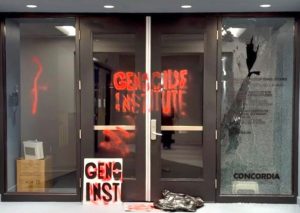“The Spirit of Byng” remains ineffable, even for those who passed through the fabled high school’s doors, but they are sure it existed.
Baron Byng High School, the Protestant public school that was the alma mater of generations of Jewish kids in Montreal, many of whom went on to excel in numerous fields, is being memorialized through modern technology.
The website baronbynghighschool.ca has been created to preserve its history and capture its zeitgeist for generations to come.
Launched on June 6, the site showcases more than 500 artifacts and ephemera, as well as oral histories, from some 150 donors that span Byng’s existence from 1921 to 1980.
This online museum is the culmination of a project that began six years ago with a class of ’60 reunion. The original idea was a physical museum in the school’s former site on St. Urbain Street, home of the Sun Youth Organization.
When that proved unfeasible, the committee went virtual. Headed by Ted Rotsztein, the committee comprises graduates stretching from 1940 to 1976.
READ: NEW HERZLIAH SCHOOL A GO WITH $15-MILLION AZRIELI FOUNDATION DONATION
Curated by Helen Malkin (a non-Bynger), the site permits access to its treasures through several portals and different themes, linked throughout.
Malkin, who was assistant director of the Canadian Centre for Architecture for 23 years, believes the site will be valued by all with an interest in Montreal history.
The site tells that history through the school’s teachers and students, with a section on over 70 of its most remarkable graduates.
Every edition of the yearbook, the Echo, from 1949-1980, has been scanned, and there are more than 20 videotaped interviews.
One section uses the floor plan of the school to assign each “room” a different theme, such as music, art and sports – important activities in Byng’s glory days.
The oldest document in the collection is the typewritten 1922 Revision of the rules for basketball.
These kids – especially those in 1930s-’50s – may have performed well academically, but they were not all angels and much of their education was acquired outside the classroom. There were, notably, three pool halls nearby.
In recognition of that, photos of a pool cue and the infamous strap for corporal punishment have become icons. There’s a link to the page in Irving Layton’s memoir where he recalls getting “biffed.”
Up to the ’60s, almost all of Byng’s students were Jewish. They lived in the close-knit Jewish neighbourhood and generally came from working-class, immigrant families. There was a lot of pressure on these children to do well.
As renowned cancer researcher Dr. Phil Gold (’53) observed: “Our parents didn’t really care what we did as long as we got good marks. And we did well, we broke out of the ghetto.”
Some were immigrant themselves, like Polish-born Rotsztein, who immigrated to Montreal in 1956 from Uruguay, not knowing a word of English. Fortunately, a classmate translated everything into Yiddish for him.
Among the more than 120 former students who attended the launch, held at the University Club of Montreal – an elite private enclave they never would have dreamed entering in their youth – were retired Supreme Court justice Morris Fish, former MNA Harry Blank, artist Rita Briansky, former McGill University dean of medicine Abe Fuks, former Quebec Court of Appeal judge Joseph Nuss; and businessman and engineer Lorne Trottier (a major sponsor of the project).
Notable alumni also include writer Mordecai Richler; Sydney Shulemson, the highest-ranking Jewish officer during World War II; actress Marilyn Lightstone; NDP leader David Lewis; former Quebec justice minister Herbert Marx, and Rudolph Marcus who won the Nobel Prize for chemistry in 1992, attesting the breadth of achievement.
Two alumni of the class of ’39, which continues to hold reunions, were present: chartered accountant Eddie Wolkove and biochemist Sam Levy. Children and even grandchildren represented those who have died or were unable to attend, among them Sandor Klein, son of poet and lawyer A.M. Klein, and Lewis Dobrin, son of Steinberg supermarket chain executive Mel Dobrin.
READ: SOME MONTREAL HAREDI SCHOOLS STILL NOT COMPLYING WITH LAW: REPORT
Two teachers offered their reminiscences: Clifford Ford, who taught math from 1954 to 1959, who remembered how motivated the students were and the dedication of the teachers, and Robert Kouri, principal from 1972 to 1980.
The names of all students and teachers since 1945 are listed by decade and class number, as well as many of those before that are so far documented. The site is a work in progress, with additions welcome.
Byng’s demographics changed in the latter decades. In the ’60s, there was an influx of Moroccan Jewish students and a French section was created. Journalist Evelyne Abitbol entered its first class in 1964, the year she immigrated to Montreal. Francophone, non-Catholics were not permitted to attend Catholic public schools in those days.
By the 1970s, there were a significant number of students of Greek and other origins.






